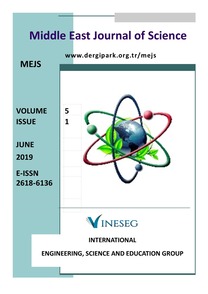EVALUATING CARROT AS A FUNCTIONAL FOOD
EVALUATING CARROT AS A FUNCTIONAL FOOD
Apiaceae, medicinal plant Vitamin C, beta-carotene,
___
- [1] Char, C.D., Carrots (Daucus corota, L), Fruit and Vegetable Phytochemicals, in: Chemistry and Human Health (Ed. E.M. Yahia), Second Edition, John Wiley & Sons, Inc., 111 River Street, Hoboken, NJ 07030, USA, pp 969-978, 2018. [2] Koley, T.K., Singh, S., Khemariya, P., Khemariye, P., Sarkar, A., Kaur, C., Chaurasia, S.N.S., Naik, P.S., “Evaluation of bioactive properties of indian carrot (Daucus carota L.): a chemometric approach”, Food Res. Int., 60, 76–85, 2014. [3] Rodriguez-Concepcion, M., Stange, C., “Biosynthesis of carotenoids in carrot: an underground story comes to light”, Arch. Biochem. Biophys., 539, 110–116, 2013. [4] Tapiero, H., Townsend, D.M., Tew, K.D., “The role of carotenoids in the prevention of human pathologies” Biomed. Pharmacother., 58, 100–110, 2004.[5] Arscott, S.A., Tanumihardjo, S.A., “Carrots of many colors provide basic nutrition and bioavailable phytochemicals acting as a functional food”, Compr Rev Food Sci Food Saf., 9(2), 223–239, 2010. [6] Bahorun, T., Luximon-Ramma, A., Crozier, A., Aruoma, O.I., “Total phenol, flavonoid, proanthocyanidin and vitamin c levels and antioxidant activities of mauritian vegetables. J. Sci. Food Agric., 84, 1553–1561, 2004. [7] Kammerer, D., Carle, R., Schieber, A., “Quantification of anthocyanins in black carrot extracts (Daucus carota ssp. sativus var. atrorubens Alef.) and evaluation of their properties”, Eur. Food Res. Technol., 219, 479–486, 2004. [8] Christensen, L.P., Brandt, K., “Bioactive polyacetylenes in food plants of the apiaceae family: occurrence, bioactivity and analysis”, J. Pharm. Biomed. Anal, 41, 683–693, 2006. [9] Czepa, A., Hofmann, T., “Quantitative Studies and sensory analysis on the influences of cultivar, spatial tissue distribution, and industrial processing on the bitter off-taste of carrots (Daucus carota L.) and carrot products”, J. Agr. Food Chem., 52, 4508-4514, 2004. [10] USDA, National Nutrient Database for Standard Reference Release 28, Basic Report: 11124, carrots, raw. United States Department of Agriculture, Agricultural Research Service. http://ndb.nal.usda.gov/ndb/foods/ show/2901, accessed 04.11.2018, 2015.[11] Marlett J.A., “Content and composition of dietary fiber in 117 frequently consumed foods”, J. Am. Diet. Assoc., 92, 175–186, 1992.[12] FAO, Human Vitamin and Mineral Requirements. Report of a Joint FAO/WHO Expert Consultation, Bangkok, Thailand. Food and Agriculture Organization of the United Nations. http://www.fao.org/3/a-y2809e. pdf, accessed 04.11.2018, 2011. [13] Mazza, G., “Anthocyanins and heart health”, Ann. Ist. Super. Sanita., 43, 369-374, 2007. [14] Kjeldsen, F., Christensen, L.P., Edelenbos, M., “Quantitative analysis of aroma compounds in carrot (Daucus carota L.) cultivars by capillary gas chromatography using large-volume injection technique”, J. Agric. Food Chem., 49, 4342-4348, 2001.[15] Guler Z., Karaca, F., Yetisir, H., Yıldiz, F., “Identification of volatile organic compounds (VOCs) in different colour carrot (Daucus carota L.) cultivars using static headspace/gas chromatography/mass spectrometry”, Cogent Food Agric., 1(1), 1117275, 2015. [16] Singh, D.P., Beloy, J., Mclnerney, J.K., Day. L., “Impact of boron, calcium and genetic factors on vitamin C, carotenoids, phenolic acids, anthocyanins and antioxidant capacity of carrots (Daucus carota)”, Food Chem., 132,1161–1170, 2012.[17] Gonzalvez, A.G., Martin, D., Slowing, K., Gonzalez Ureña, A., “Insights into the β-Carotene distribution in carrot roots”, Foodstructure, 2, 61–65, 2014.[18] Ma, T., Tian, C., Luo, J., Zhou, R., Sun, X., Ma, J., “Influence of technical processing units on polyphenols and antioxidant capacity of carrot (Daucus carrot L.) juice”, Food Chem., 141, 1637–1644, 2013. [19] Vasudevan, M., Gunnam, K., Parle, M. “Antinoceptive and antiinflamatory properties of Daucus carota seeds extracts”, J. Health Sci., 52, 598-606, 2006.[20] Rao, R., Reedy, S., “Hypoglycaemic and antidiabetic activity of Daucus carota seeds in alloxan induced diabetic rats”, Pharmanest 4, 907-9013, 2013. [21] Shebaby, W., El-Sibai, M., Bodman-Smith, K., Karam, M.C., Mroueh, M., Daher, C., “The antioxidant and anticancer effects of wild carrot oil extract”, Phytother. Res., 27, 737-744, 2013.[22] Khalil, N., Ashour, M., Singab, A.N., Salama, O., “Bioassay guided fractionation and cytotoxic activity of Daucus carota var. boissieri”, Future J. Pharm. Sci., 4, 14-17, 2018. [23] Haskell, M.J., Pandy, P., Graham, J.M., Peerson, J.M., Shrestha, R.M., Brown, K.H., “Recovery from dark adaptation in nightblind pregnant women who receive small daily doses of vitamin A as amaranth leaves, carrots, goat liver, vitamin A-fortified rice, or retinyl palmitate”, Am. J. Clin. Nutr., 81: 461–471, 2005. [24] Ross, A.C., Restori, K.H., Vitamin A and the Immune System, in: Diet, Immunity and Inflammation (Eds. Calder, P.C., Yaqoob, P.), Woodhead Publishing, pp. 221–243, 2013. [25] Saleem, M.Q., Akhtar, S., Imran, M., Riaz, M., Rauf, Mubarak, M.S., Bawazeer, S., Bawazeer, S.S., Hassanien, M.F.R., “Antibacterial and anticancer characteristics of black carrot (Daucus carota) extracts”, Z Arznei- Gewurzpfla., 22(1), 40–44, 2018.[26] Alves-Rodrigues, A., Shao, A., “The science behind lutein”, Toxicol. Lett., 150, 57–83, 2004. [27] Meléndez-Martínez, A.J., Vicario, I.M., Heredia, F.J., “Provitamin A carotenoids and ascorbic acid contents of the different types of orange juices marketed in Spain”, Food Chem., 101, 177-184, 2007. [28] Hallberg, L., Brune, M. and Rossander-Hulthen, L., “Is there a physiological role of vitamin c in iron absorption?”, Ann N. Y. Acad. Sci., 498(1), 324–332, 1987. [29] Metzger, B.T., Barnes, D.M., Reed, J.D., “Purple carrot (Daucus carota L.) polyacetylenes decrease lipopolysaccharide-induced expression of inflammatory proteins in macrophage and endothelial cells”, J. Agric. Food Chem., 56, 3554–3560, 2008.[30] Zidorn, C., Johrer, K., Ganzera, Shubert, B., Sigmund, E.M., Mader, J., Greil, R., Ellmerer, E.P., Stuppner, H., “Polyacetylenes from the Apiaceae vegetables carrot, celery, fennel, parsley, and parsnip and their cytotoxic activities”, J. Agric. Food Chem., 53, 2518–2523, 2005. [31] Karkute, S.G., Koley, TK, Yenkhom, BK, Tripathi, A, Srivastava, S, Maurya, A, Singh, B., “Anti-diabetic phenolic compounds of black carrot (Daucus carota Subspecies sativus var. atrorubens Alef.) inhibit enzymes of glucose metabolism: an in silico and in vitro validation”, Med. Chem., 14(6), 641-649, 2018.
- ISSN: 2618-6136
- Yayın Aralığı: 2
- Başlangıç: 2015
- Yayıncı: -
EXISTENCE OF A SOLUTION OF A REACTION-DIFFUSION TYPE OF PROBLEM AND AN APPLİCATION
PERFORMANCE ANALYSIS OF CLASSIFICATION ALGORITHMS OF SEVERAL DATA MINING SOFTWARES
Abdullah BAYKAL, Cengiz COŞKUN
EVALUATING CARROT AS A FUNCTIONAL FOOD
Muharrem ERGUN, Zahide SÜSLÜOĞLU
RESEARCH OF LAVENDER PLANT PROPAGATION IN THE PROVINCE OF DİYARBAKIR
BLOW UP OF SOLUTIONS FOR A TIMOSHENKO EQUATION WITH DAMPING TERMS
